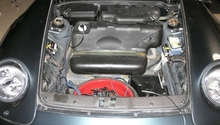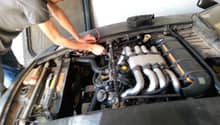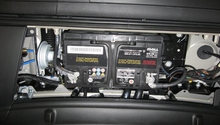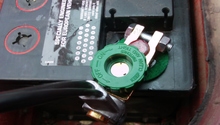Porsche 997: How to Jump Start Car
Jump starting your Porsche 997 isn't difficult, but there are a few things to keep in mind before swinging those battery cables around.
This article applies to the Porsche 997 (2005-2012).
Your car needs three things to run: air, fuel, and spark. If your battery is dead, then all the air and fuel in the world isn't going to be any good because you won't have any spark to ignite them. Technically, if you could squeeze a fuel air mixture tight enough it would eventually explode, but that's another article for another time. This one addresses a dead battery. You're going to use the battery from a car that is not your Porsche to start your Porsche. Don't worry, using an inferior car in this way won't affect your car's drive-ability.

Materials Needed
- Jumper cables
- Assistant/helper (optional)
- Another car with the same voltage battery
Step 1 – Make sure both cars use 12 volt batteries
Most cars are 12 volt, but some older classics aren't. Motorcycles usually aren't either. Make sure the car you are using to jump your car has a 12 volt battery. It should tell you right on the battery itself what the voltage is. If you accidentally use a smaller battery, it will probably make some smoke and then stop working, if not something worse. Then you'll have two dead batteries and at least one irritated person, so be careful.
Warning
Make sure the cars aren't touching. If metal is touching metal, the result could be bad; current could flow where it isn't wanted.

Step 2 – Make sure your battery is connected properly
You probably already thought of this, but this step is just be double sure. Open the plastic panel at the top of the inside of your front trunk (or frunk) and verify that your battery cables are connected. Things happen; maybe one wiggled loose. Probably not, but maybe!
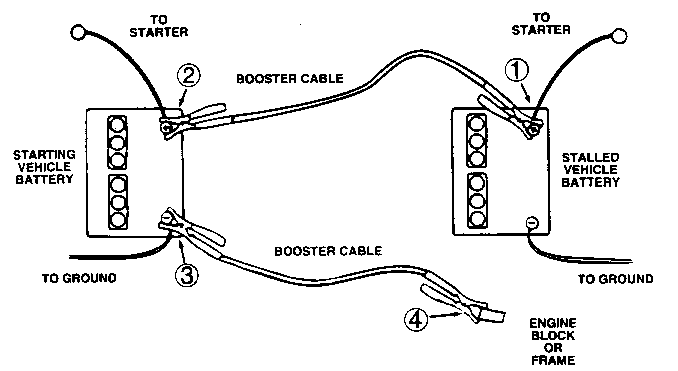
Step 3 – Connect one positive (+, red) lead to the discharged battery
Refer to Figure 2. Make sure that none of the other leads are touching each other or parts of either car. It helps to have someone assisting you with this process so they can watch one end of the cables while you watch the other.
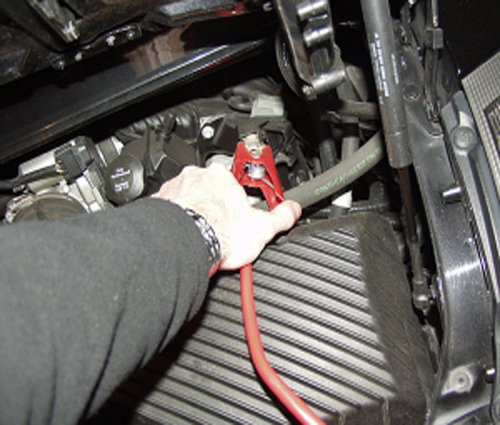
Step 4 – Connect the other positive (+, red) lead to the charged battery
Referring to Figure 2 again, connect the positive red lead to the charged battery.
Step 5 – Connect the negative (-, black) lead to the charged battery's negative terminal
Refer to Figure 2 if necessary. Connect the negative black lead to the negative terminal.
Warning
Be extra careful after doing this, because the leads on the discharged end are now energized. If they touch, they will make sparks and could damage both batteries, both alternators, or anyone nearby.

Step 6 – Connect the last remaining lead to a grounding point on your car
Any substantial, unpainted metal part of the car should do. If you can't find one, you can connect the lead directly to the battery terminal, but using a grounding point is preferred because it's safer.
Step 7 – Run the donor car's engine up a bit
Get the donor car's engine going higher than idle so that its charging system is engaged. This is typically above 1500 RPM. You don't want to make the engine scream, just get it up high enough that it's working as normal.

Step 8 – Attempt to start your car
Try starting the car for no more than 15 seconds. If you need a second try, wait at least a minute between attempts to give the donor car time to try to charge up your car.
Step 9 – Disconnect cables in reverse order that they were connected
Congratulations! Your car is running again (hopefully). If not, verify that you have done the above properly, and seek the advice of a professional if needed.
Pro Tip
A trickle charger will help keep batteries charged, especially in vehicles that don't see much road time over the winter. At as low as $20, they're an easy way to keep your battery charged up and happy.
For Manuals Only – The Bump Start
This is really a try-at-your-own-risk alternative. It is possible to start most manual transmission cars without a donor car. Be aware that this is not advised. In fact, it's strictly forbidden by your Porsche manual. It's dangerous, unreliable, and might cause damage to your car and/or void your warranty. That said, if you're sure you want to do it, here's how.
Put the car in 2nd gear, with the key in the ignition's normal running position and your foot on the clutch pedal. Get the car rolling, either by going down a hill or by asking some friends to help push. It doesn't need to be going any faster than jogging pace. When it's moving along, pop the clutch and give the car a bit of gas. The momentum of the moving car manually spins the crank and forces the engine into life. Again, only do this in an area with sufficient room to do so.
Related Discussions
- Dead Battery - How Do You Jump Start This Thing? - Rennlist.com
- Car Won't Start - Jump Start Question - Rennlist.com
- Is It OK. to Jump Start? - Rennlist.com

